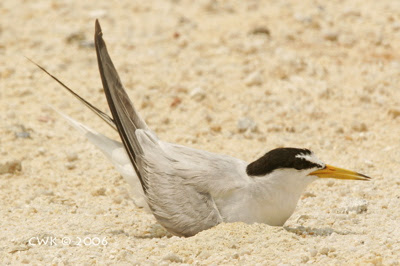Things are not always smooth sailing for the chicks of the Little Tern (Sterna albifrons) once they hatch. There is no guarantee that they would develop normally to eventually fledge. In fact not all chicks survive the 20 odd days to fledging.
When Jonathan Cheah was documenting the breeding ecology of the Little Terns (1,, 2), he noticed a larger chick limping through the viewfinder of his camera. As he moved closer he noticed one leg bleeding as the chick hobbled over a sand mound. He went over and found it lying motionless, a usual reaction when a chick is approached. Lifting the chick off the ground, he noticed a foreign object lodged on the chick’s webbed foot. After removing the object he gently placed the chick on the sand and it scuttled off happily (below). 



And he also experienced death of chicks. As Jonathan recounts, “The first two days of hatching are very crucial to the survival of the chicks. Failed nests can occur by bad choice of nesting grounds, too many eggs, even stress of parent by predators. Once the chicks can move, the survival rate increases.“ 

Around the nesting grounds he observed chicks dying (above) but the parent birds do not normally accept the fact that the chicks were dead. In one instance the parent covered the chick’s beak with a rock to prevent ants from entering the carcass. It even continued to sit on the remaining egg and dead chick, whilst being harassed by the sudden increase in flies and ants (below).
Unfortunately the remaining egg did not hatch, most probably due to a super heated ground. Obviously a poor choice of nesting location.
Input and images by Dr Jonathan Cheah Weng Kwong.











